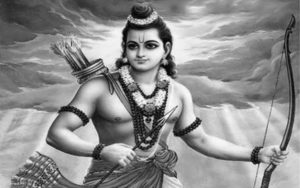In sanatana dharma, birthdays of great people are celebrated as jayantis and death anniversaries are remembered as aradhanas. Sri Rama Navami is the birthday of Rama, the unparalleled hero known as the embodiment of dharma, dignity, honor, compassion, and capability. It is often believed that Rama was the avatara of the great deity Vishnu. The name 'राम' has come from the root ‘रम् क्रीडायाम्’ meaning 'play' or 'enjoyment.' The semantic etymology of the name 'राम' – रमते इति रामः also means the same thing, i.e, he who roams and plays in the hearts of the yogis resulting in mutual ecstasy. Therefore Rama, according to our tradition has the embodiment of highest bliss called ‘ब्रह्मानन्द’. The whole story of Ramayana is a profound spiritual symbol. Thus, remembering Rama is a meaningful step towards the realization of one’s own self.
The birthday of Rama is celebrated on the ninth day of the bright part of the lunar month of chaitra in spring season. If Rama’s birth star ‘पुनर्वसु’ coincides with this day, the auspiciousness of Sri Rama Navami is supposed to increase by a billion times. According to the lunar calendar the ‘तिथि’ of ‘नवमि’ should at least extend up to the noon of that day.
There are many ways of celebrating Sri Rama Navami starting from a single day festival up to a celebration of nine days. The most important ritual is, however, confined to the day. A full day fast is observed. Rama is worshiped in the usual methods of षोडशोपचार where ceremonial invocation, shower, decoration, offering, and chanting are involved. Even fire rituals are prescribed. Many people recite रामतारकमन्त्र and offer one-tenth of the number of japas in the form of fire rituals. Ceremonial study of Ramayana known as ‘पारायण’ is carried out. The Ramacharitamanas of Tulsidas composed in Braj is very popular in North India. The Hindi belt often prefers the work of Tulsidas for पारायण. However, it is the work of sage Valmiki in Sanskrit that is the most preferred one for पारायण.
Salads and raw cereals soaked in water and seasoned well along with fruits, their juices, lemonades, and seasoned butter-milk are offered to the lord as ‘नैवेद्यम्’ and are in turn distributed among the friends, relatives, and the poor. Fruits like papaya, watermelon, and banana which contain high percentage of water are specially meant for this purpose. This pattern of ‘नैवेद्यम्’ has a great significance in connection with health. According to the ‘ऋतुचर्या’ of Ayurveda, this food-feature becomes a pointer towards the nature of consumption in summer. Thus, Sri Rama Navami not only caters to faith but also to healthcare.
The third dimension of life that comprises of aesthetics and motivation is very well managed through the enjoyment of poetry, music, dance, theater, and many more crafts. In sum, Sri Rama Navami is a holistic festival like any other important day of observation in sanatana dharma. This naturally breeds the joy of spirit that never negates the duties of the world.














































